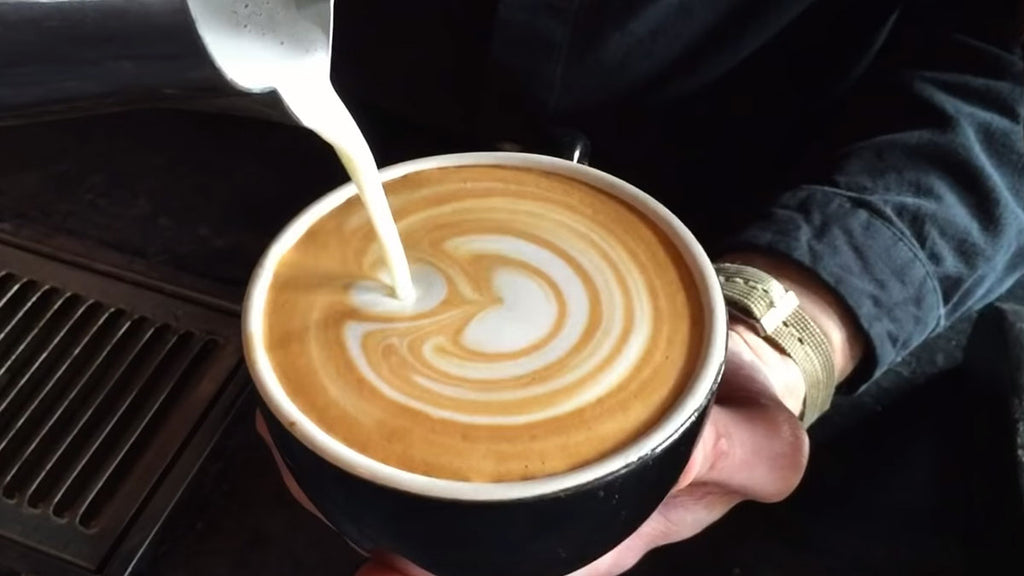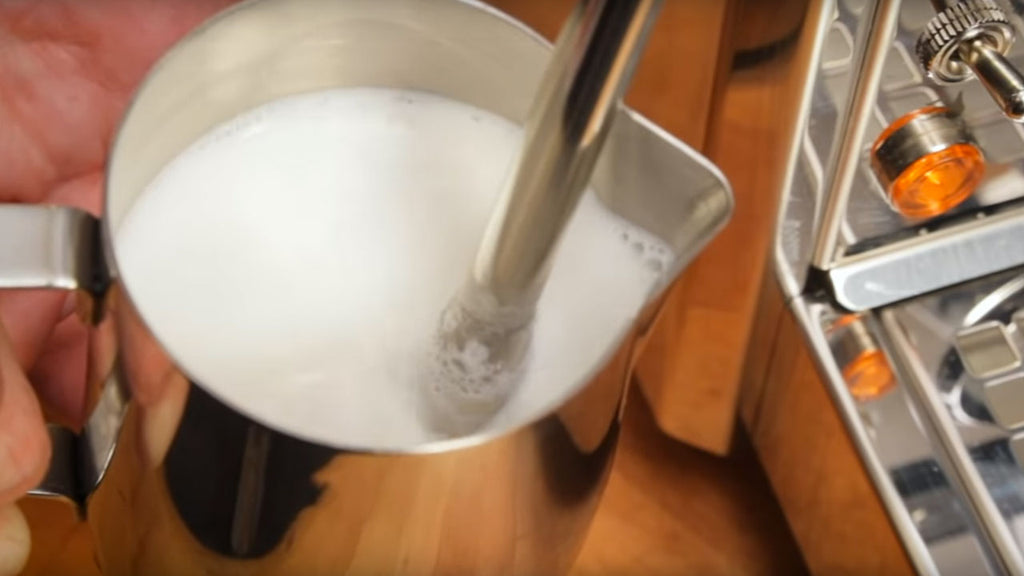My Milk Comes Out Too Frothy to Make Latte Art
Updated for 2021
Hey latte, cappuccino, flat white, cortado, and macchiato lovers, Marc here from Whole Latte Love. Today I've got v tips to help y'all get the all-time barm for your milk-based espresso beverages, including some bonus content with our test results for 10 dairy and non-dairy milks. Find out what types of milk are best based on frothing quality, pouring quality, and gustation.
Coming upward in this blog, I've got some pictures comparing the differences in technique for producing a barista quality, super-fine froth for pouring latte fine art compared to a dryer, airier milk foam for a traditional cappuccino. In addition, if you're on a quest to go a latte art DaVinci, go the basics down in this web log, then use the link here to lookout our video: "How to Froth and Steam Milk for Latte Art and More". With nearly 3 million views, it'south definitely a must-encounter if milk drinks are your affair. It'southward a classic stride-by-step guide to producing corking tasting and beautiful looking milk-based espresso beverages. In that one you'll larn how to pour latte art including a eye, rosetta, and tulip.
At that place are 5 topics I'll cover in this video:
At present in this blog I'll be focusing on manual steaming, but if you're using an machine-frothing wand there's plenty of information here for you besides. Beyond that, see these videos on how to go the all-time from auto-frothing steam wands.
Best Practices

If you lot're new to frothing, I advise you to start with a 12 oz pitcher, that's about 350 ml. It's got enough volume to do milk for a larger latte, it'due south easy to handle, and even most entry-level budget machines should have enough ability to steam milk in these. I've got a variety hither from the archetype Rattleware Latte Fine art Pitcher and some await-alikes, on up to the Espro Toroid with a pattern to help encourage milk rotation that may benefit machines with less steaming ability.
Always start with milk that's as cold as possible — it takes air ameliorate, and gives y'all more than time to piece of work it. Some people even shop their pitchers in the freezer. For fill level, effort going to just below where the spout starts to course. In these size pitchers, that'll go you lot about 5 or 6 ounces, enough for a large latte. If that's too much, you can go with less, but you probably don't want to add together more than every bit the milk will aggrandize when frothed.
Before steaming, make sure your machine is up to steam temperature. This is especially true with single boiler machines, which tin take a infinitesimal to get there after flipping the steam switch. A tip for getting a fiddling more steam out of some single boiler machines: once yous know how long it takes for the machine to get to steam temperature, you can start steaming a few seconds earlier the machine indicates it's reached full temp. Doing that with many single boiler machines will crusade the heating element to stay on, generating more than steam while you're frothing. If you wait until the machine indicates it's ready, the element will probably plow off and stops generating steam while you're frothing. That doesn't work with all single boilers, especially those with thermoblocks, but give it a endeavour with yours and you might go a little actress steam power.
Other best practices come up down to what I'll call purge, wipe, purge. Purge your wand immediately earlier steaming to remove any water that's in the steaming circuit. Yous don't want that extra h2o in your milk. Then as soon every bit y'all're done frothing, use a towel to wipe your wand before milk has a adventure to broil on. Then, purge again. The final purge is very of import. When y'all end steaming the tip is even so in the milk. As the wand quickly cools, milk is drawn up into the wand but that final purge gets the milk out. Nosotros have had cases where people didn't purge properly and milk can get all the style dorsum to the boiler, and that's a stinky mess. And so always purge after steaming.
To recap best practices:
Temperature
Before I become to the technique of steaming, I want to talk well-nigh proper milk temperature. And so the whole idea behind frothing milk is creating a sweet, flossy texture. Heating milk increases its apparent sweetness, but just to a point. Now, if y'all're newer to milk-based espresso beverages, you might be expecting a temperature closer to a regular drip mode java. That should never be the case.
Milk is at its sweetest from 135-150°F. That's 57-66°C. As yous go hotter, you lose the sweet. If you go likewise hot, you'll scald the milk. To go the proper temperature you tin can apply a frothing thermometer or practice information technology by experience. If using a thermometer, be aware of lag. After you turn off the steam y'all can expect the temperature to ascent every bit much as 10°F or 5°C, so cut the steam before you see your desired temp on the thermometer. If judging temperature by feel, you've hit the sugariness spot when the outside of the pitcher is simply beginning to become uncomfortable to concur due to heating. So that's when you desire to cut the steam.
Frothing Technique
Frothing technique is all near finding the proper steam tip position relative to the surface of the milk. Also low in the milk and you won't go enough air in. As well high and you'll either get too much air in or make a big mess. So the idea is to start with the steam tip merely below the surface of the milk. Then adjust the depth so you hear the occasional rip, which indicates small amounts of air existence sucked into the milk.
Now, whether you want a super-fine micro-foam for a latte or an airier froth for a traditional cappuccino, the showtime of the process is the same. You want to get rips of air in as before long equally possible. Milk takes in air better when colder. For a fine latte froth all air should be in past the time the outside of the pitcher starts to warm. At that point you position the wand a hair deeper into the milk and find a tip position and bending which causes the milk to roll. That curl helps pause up any larger bubbles and mixes the milk to create a uniform texture through the pitcher.
For airier cappuccino froth y'all can proceed sucking in rips of air a little longer and gauge the froth past its expansion in the pitcher. When y'all get the desired volume, lower the wand into the milk a hair and continue rolling. When you've reached your desired temperature, shut the steam off with the tip still in the milk, remove the pitcher, wipe down the wand, and don't forget that final purge to get residual milk out of the steam wand.

Later steaming, if you find you have some larger bubbles you tin can knock and swirl the pitcher a few times to assist break up and mix those.
To recap frothing technique:
Milk Type
In a second I'll get to how you can practice all this without using any milk, simply get-go a quick wait at dairy and non-dairy milk types and ratings based on our frothing, pouring, and sense of taste tests.
Some notable results: whole fat dairy milk is the gold standard. Information technology scored 5/5 in frothing, pouring and sense of taste for fifteen points full. Our dairy milk runner up was a surprise. It was Lactaid milk, which scored 14/15 points, slightly edging out two pct milk, which had a score of thirteen/fifteen. Our testers really liked the sweetness of the Lactaid milk.
We had another surprise in non-dairy milks. Now almond milk is ane of the standard milk alternatives in coffee shops. It scored 8/15 points, slightly edging out another pop culling, soy milk, which scored 7/xv points. Our winner in not-dairy was macadamia milk with eleven/fifteen points. Non-dairy milks typically fall short in frothing, merely our testers liked the sweet nutty aroma of the macadamia milk.
Get our complete results, including testing of cashew, oat, coconut, and that goat milk, which froths well, but putting information technology nicely was face-twistingly overwhelming.
Practice
So, y'all actually want to amend your frothing skills or practice latte art. Well, here'south how you lot can exercise it all solar day long without using whatever milk or espresso. For the milk just use plain water and add together a driblet or two of dish soap. That combination behaves nearly identically to milk when frothed.
We had Sapphire, a local barista who does incredible latte art, in the studio a while back and she gave usa a really cool technique to exercise pouring. But add a drop of food coloring to a couple ounces of hot water in a latte cup for dissimilarity and and so use the soapy froth to pour your art. Anyone for a blue latte? Ya, you don't really want to beverage that one, but you can practice all solar day long and your equipment volition exist extra clean — just don't forget to purge that steam wand.
I'm Marc, thanks for reading and I invite you to come back shortly for more of the best on everything coffee brought to you by Whole Latte Love.
Source: https://www.wholelattelove.com/blogs/how-to/milk-frothing-for-beginners-5-tips
0 Response to "My Milk Comes Out Too Frothy to Make Latte Art"
إرسال تعليق